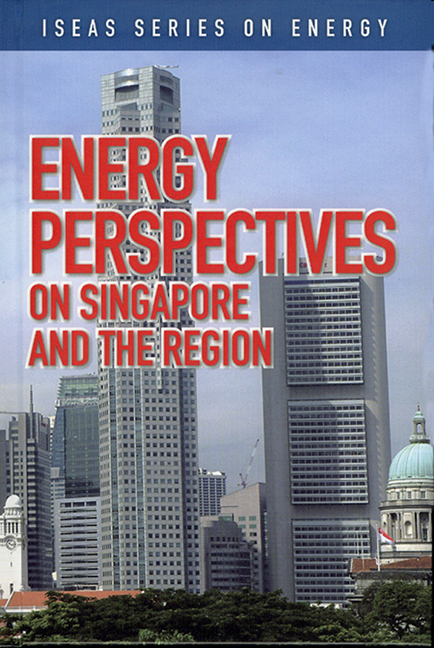Book contents
- Frontmatter
- Contents
- Foreword
- Preface
- The Contributors
- 1 Overview of Singapore's Energy Situation
- 2 Singapore's Changing Landscapes in Energy
- 3 Singapore's Role as a Key Oil Trading Centre in Asia
- 4 Large-Scale Solar PV Power Generation in Urban High-Rise Buildings in Singapore
- 5 The High-Carbon Story of Urban Development in Southeast Asia
- 6 Renewable Energy and the Environment: Technology and Economic Perspectives
- 7 Delivering Results in a Booming Rig Market
- 8 The Success Story of Rig Building in Singapore
- 9 The Singapore Oil Situation
- 10 Singapore Petroleum Company: Adding Value to the Singapore Oil Industry
- 11 Oil Storage: The Singapore Story
- REGIONAL and INTERNATIONAL
- 12 The Outlook for Energy: A View to 2030
- 13 India's Energy Situation: The Need to Secure Energy Resources in an Increasingly Competitive Environment
- 14 The Implications and Impacts of China's Oil Demand on the Asia Pacific
- 15 Energy Security Cooperation in Asia: An ASEAN-SCO Energy Partnership?
- 16 China's Energy Security: Geo-politics versus Interdependence
- 17 The Strategic Challenges for the United States and China in Global Energy Supply
- 18 China's Coal: Curse or Blessing
- 19 Japan's New Energy Strategy
- 20 Who Wins in the Asian Scramble for Oil?
- 21 New Horizons for Liquefied Natural Gas (LNG) East of Suez
- 22 Bio and Synthetic Fuels: An Alternative for Sustainable Mobility
- 23 Price Discovery for Middle East Refined Product Exports: A Natural Role for Dubai
- 24 The Outlook for Gas in Southeast Asia
- 25 Sakhalin-2 Project, a New Energy Source for the Asia Pacific: History in the Making
- Index
24 - The Outlook for Gas in Southeast Asia
from REGIONAL and INTERNATIONAL
Published online by Cambridge University Press: 21 October 2015
- Frontmatter
- Contents
- Foreword
- Preface
- The Contributors
- 1 Overview of Singapore's Energy Situation
- 2 Singapore's Changing Landscapes in Energy
- 3 Singapore's Role as a Key Oil Trading Centre in Asia
- 4 Large-Scale Solar PV Power Generation in Urban High-Rise Buildings in Singapore
- 5 The High-Carbon Story of Urban Development in Southeast Asia
- 6 Renewable Energy and the Environment: Technology and Economic Perspectives
- 7 Delivering Results in a Booming Rig Market
- 8 The Success Story of Rig Building in Singapore
- 9 The Singapore Oil Situation
- 10 Singapore Petroleum Company: Adding Value to the Singapore Oil Industry
- 11 Oil Storage: The Singapore Story
- REGIONAL and INTERNATIONAL
- 12 The Outlook for Energy: A View to 2030
- 13 India's Energy Situation: The Need to Secure Energy Resources in an Increasingly Competitive Environment
- 14 The Implications and Impacts of China's Oil Demand on the Asia Pacific
- 15 Energy Security Cooperation in Asia: An ASEAN-SCO Energy Partnership?
- 16 China's Energy Security: Geo-politics versus Interdependence
- 17 The Strategic Challenges for the United States and China in Global Energy Supply
- 18 China's Coal: Curse or Blessing
- 19 Japan's New Energy Strategy
- 20 Who Wins in the Asian Scramble for Oil?
- 21 New Horizons for Liquefied Natural Gas (LNG) East of Suez
- 22 Bio and Synthetic Fuels: An Alternative for Sustainable Mobility
- 23 Price Discovery for Middle East Refined Product Exports: A Natural Role for Dubai
- 24 The Outlook for Gas in Southeast Asia
- 25 Sakhalin-2 Project, a New Energy Source for the Asia Pacific: History in the Making
- Index
Summary
INTRODUCTION
Southeast Asia is diverse, including countries such as Indonesia — a large and resource rich developing country of some 13,000 islands stretching across 5,000 kilometres, Singapore — a highly developed city-state economy that imports all its energy resource needs, Cambodia — a country with low energy intensity developing from a very low economic base and Vietnam which, while still at an early stage of economic development, is experiencing double- digit growth in its energy demand and has a strong appetite for gas. In many Southeast Asian economies, urbanization is occurring rapidly and several countries are building manufacturing bases and looking to develop industries, all of which results in more gas being required to supply power demand, city gas and industrial gas applications.
Natural gas fulfils about one quarter of the primary energy needs in the region. Gas consumption in Southeast Asia was about 127 billion cubic metres (bcm) in 2005 and the majority of the gas consumed in the region, of the order of 54 per cent, was used for power generation. Regional gas consumption is expected to increase to more than 200 bcm over the next ten years, with the proportion of gas used for power expected to increase steadily from current levels. Gas offers a clean, flexible and often economic fuel option.
In addition to the growing use of gas for power generation, countries such as Thailand and Indonesia are also growing their industrial and city gas markets, while in Brunei, the Philippines and Vietnam, gas is used almost entirely for power. Malaysia has grown its gas-fired power generation and now about 70 per cent of power is generated from gas and it has constructed a Peninsular Gas Utilization grid to extend gas supply to industry and commerce. In Indonesia there is potential for significantly increased demand for gas beyond what it is currently able to supply. Indonesia is at a critical point where more gas is required to support both domestic development for power and industrial use and to maintain its liquefied natural gas (LNG) exports.
- Type
- Chapter
- Information
- Energy Perspectives on Singapore and the Region , pp. 317 - 336Publisher: ISEAS–Yusof Ishak InstitutePrint publication year: 2007

